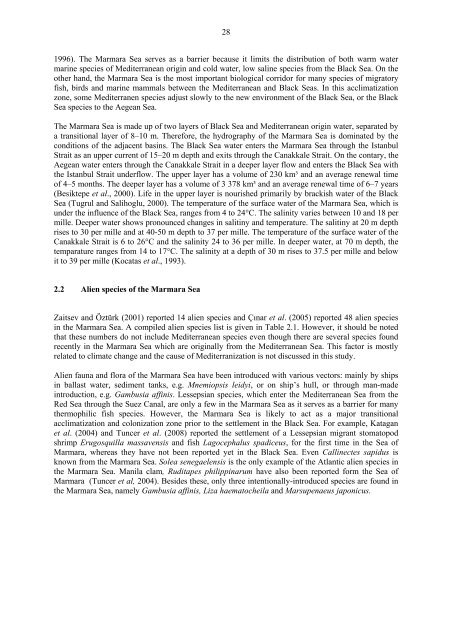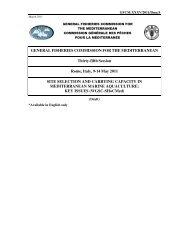Status of alien species in the Mediterranean and Black Sea
Status of alien species in the Mediterranean and Black Sea
Status of alien species in the Mediterranean and Black Sea
You also want an ePaper? Increase the reach of your titles
YUMPU automatically turns print PDFs into web optimized ePapers that Google loves.
28<br />
1996). The Marmara <strong>Sea</strong> serves as a barrier because it limits <strong>the</strong> distribution <strong>of</strong> both warm water<br />
mar<strong>in</strong>e <strong>species</strong> <strong>of</strong> <strong>Mediterranean</strong> orig<strong>in</strong> <strong>and</strong> cold water, low sal<strong>in</strong>e <strong>species</strong> from <strong>the</strong> <strong>Black</strong> <strong>Sea</strong>. On <strong>the</strong><br />
o<strong>the</strong>r h<strong>and</strong>, <strong>the</strong> Marmara <strong>Sea</strong> is <strong>the</strong> most important biological corridor for many <strong>species</strong> <strong>of</strong> migratory<br />
fish, birds <strong>and</strong> mar<strong>in</strong>e mammals between <strong>the</strong> <strong>Mediterranean</strong> <strong>and</strong> <strong>Black</strong> <strong>Sea</strong>s. In this acclimatization<br />
zone, some Mediterranen <strong>species</strong> adjust slowly to <strong>the</strong> new environment <strong>of</strong> <strong>the</strong> <strong>Black</strong> <strong>Sea</strong>, or <strong>the</strong> <strong>Black</strong><br />
<strong>Sea</strong> <strong>species</strong> to <strong>the</strong> Aegean <strong>Sea</strong>.<br />
The Marmara <strong>Sea</strong> is made up <strong>of</strong> two layers <strong>of</strong> <strong>Black</strong> <strong>Sea</strong> <strong>and</strong> <strong>Mediterranean</strong> orig<strong>in</strong> water, separated by<br />
a transitional layer <strong>of</strong> 8–10 m. Therefore, <strong>the</strong> hydrography <strong>of</strong> <strong>the</strong> Marmara <strong>Sea</strong> is dom<strong>in</strong>ated by <strong>the</strong><br />
conditions <strong>of</strong> <strong>the</strong> adjacent bas<strong>in</strong>s. The <strong>Black</strong> <strong>Sea</strong> water enters <strong>the</strong> Marmara <strong>Sea</strong> through <strong>the</strong> Istanbul<br />
Strait as an upper current <strong>of</strong> 15–20 m depth <strong>and</strong> exits through <strong>the</strong> Canakkale Strait. On <strong>the</strong> contary, <strong>the</strong><br />
Aegean water enters through <strong>the</strong> Canakkale Strait <strong>in</strong> a deeper layer flow <strong>and</strong> enters <strong>the</strong> <strong>Black</strong> <strong>Sea</strong> with<br />
<strong>the</strong> Istanbul Strait underflow. The upper layer has a volume <strong>of</strong> 230 km³ <strong>and</strong> an average renewal time<br />
<strong>of</strong> 4–5 months. The deeper layer has a volume <strong>of</strong> 3 378 km³ <strong>and</strong> an average renewal time <strong>of</strong> 6–7 years<br />
(Besiktepe et al., 2000). Life <strong>in</strong> <strong>the</strong> upper layer is nourished primarily by brackish water <strong>of</strong> <strong>the</strong> <strong>Black</strong><br />
<strong>Sea</strong> (Tugrul <strong>and</strong> Salihoglu, 2000). The temperature <strong>of</strong> <strong>the</strong> surface water <strong>of</strong> <strong>the</strong> Marmara <strong>Sea</strong>, which is<br />
under <strong>the</strong> <strong>in</strong>fluence <strong>of</strong> <strong>the</strong> <strong>Black</strong> <strong>Sea</strong>, ranges from 4 to 24°C. The sal<strong>in</strong>ity varies between 10 <strong>and</strong> 18 per<br />
mille. Deeper water shows pronounced changes <strong>in</strong> salit<strong>in</strong>y <strong>and</strong> temperature. The salit<strong>in</strong>y at 20 m depth<br />
rises to 30 per mille <strong>and</strong> at 40-50 m depth to 37 per mille. The temperature <strong>of</strong> <strong>the</strong> surface water <strong>of</strong> <strong>the</strong><br />
Canakkale Strait is 6 to 26°C <strong>and</strong> <strong>the</strong> sal<strong>in</strong>ity 24 to 36 per mille. In deeper water, at 70 m depth, <strong>the</strong><br />
temparature ranges from 14 to 17°C. The sal<strong>in</strong>ity at a depth <strong>of</strong> 30 m rises to 37.5 per mille <strong>and</strong> below<br />
it to 39 per mille (Kocatas et al., 1993).<br />
2.2 Alien <strong>species</strong> <strong>of</strong> <strong>the</strong> Marmara <strong>Sea</strong><br />
Zaitsev <strong>and</strong> Öztürk (2001) reported 14 <strong>alien</strong> <strong>species</strong> <strong>and</strong> Çınar et al. (2005) reported 48 <strong>alien</strong> <strong>species</strong><br />
<strong>in</strong> <strong>the</strong> Marmara <strong>Sea</strong>. A compiled <strong>alien</strong> <strong>species</strong> list is given <strong>in</strong> Table 2.1. However, it should be noted<br />
that <strong>the</strong>se numbers do not <strong>in</strong>clude <strong>Mediterranean</strong> <strong>species</strong> even though <strong>the</strong>re are several <strong>species</strong> found<br />
recently <strong>in</strong> <strong>the</strong> Marmara <strong>Sea</strong> which are orig<strong>in</strong>ally from <strong>the</strong> <strong>Mediterranean</strong> <strong>Sea</strong>. This factor is mostly<br />
related to climate change <strong>and</strong> <strong>the</strong> cause <strong>of</strong> Mediterranization is not discussed <strong>in</strong> this study.<br />
Alien fauna <strong>and</strong> flora <strong>of</strong> <strong>the</strong> Marmara <strong>Sea</strong> have been <strong>in</strong>troduced with various vectors: ma<strong>in</strong>ly by ships<br />
<strong>in</strong> ballast water, sediment tanks, e.g. Mnemiopsis leidyi, or on ship’s hull, or through man-made<br />
<strong>in</strong>troduction, e.g. Gambusia aff<strong>in</strong>is. Lessepsian <strong>species</strong>, which enter <strong>the</strong> <strong>Mediterranean</strong> <strong>Sea</strong> from <strong>the</strong><br />
Red <strong>Sea</strong> through <strong>the</strong> Suez Canal, are only a few <strong>in</strong> <strong>the</strong> Marmara <strong>Sea</strong> as it serves as a barrier for many<br />
<strong>the</strong>rmophilic fish <strong>species</strong>. However, <strong>the</strong> Marmara <strong>Sea</strong> is likely to act as a major transitional<br />
acclimatization <strong>and</strong> colonization zone prior to <strong>the</strong> settlement <strong>in</strong> <strong>the</strong> <strong>Black</strong> <strong>Sea</strong>. For example, Katagan<br />
et al. (2004) <strong>and</strong> Tuncer et al. (2008) reported <strong>the</strong> settlement <strong>of</strong> a Lessepsian migrant stomatopod<br />
shrimp Erugosquilla massavensis <strong>and</strong> fish Lagocephalus spadiceus, for <strong>the</strong> first time <strong>in</strong> <strong>the</strong> <strong>Sea</strong> <strong>of</strong><br />
Marmara, whereas <strong>the</strong>y have not been reported yet <strong>in</strong> <strong>the</strong> <strong>Black</strong> <strong>Sea</strong>. Even Call<strong>in</strong>ectes sapidus is<br />
known from <strong>the</strong> Marmara <strong>Sea</strong>. Solea senegaelensis is <strong>the</strong> only example <strong>of</strong> <strong>the</strong> Atlantic <strong>alien</strong> <strong>species</strong> <strong>in</strong><br />
<strong>the</strong> Marmara <strong>Sea</strong>. Manila clam, Ruditapes philipp<strong>in</strong>arum have also been reported form <strong>the</strong> <strong>Sea</strong> <strong>of</strong><br />
Marmara (Tuncer et al, 2004). Besides <strong>the</strong>se, only three <strong>in</strong>tentionally-<strong>in</strong>troduced <strong>species</strong> are found <strong>in</strong><br />
<strong>the</strong> Marmara <strong>Sea</strong>, namely Gambusia aff<strong>in</strong>is, Liza haematocheila <strong>and</strong> Marsupenaeus japonicus.
















